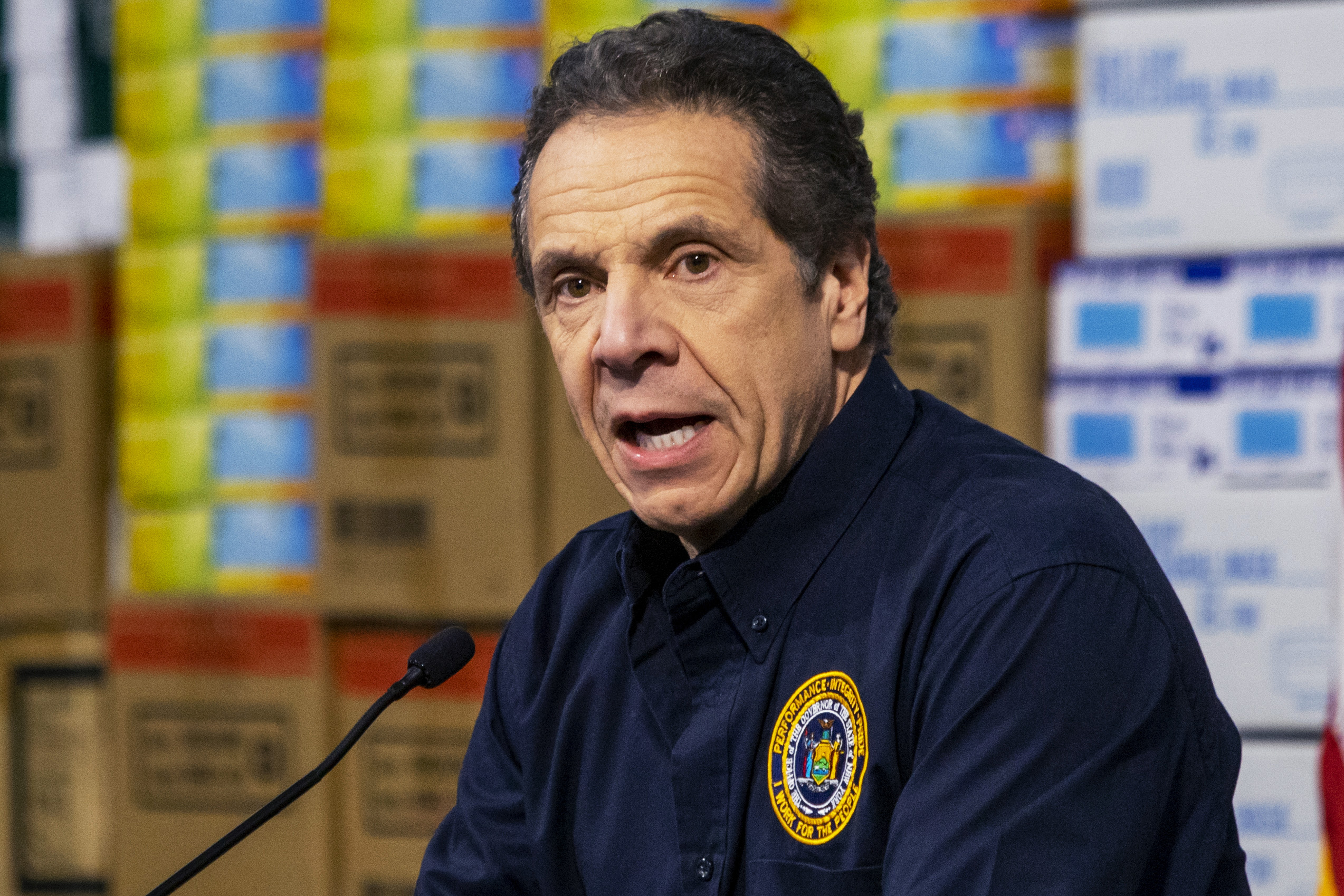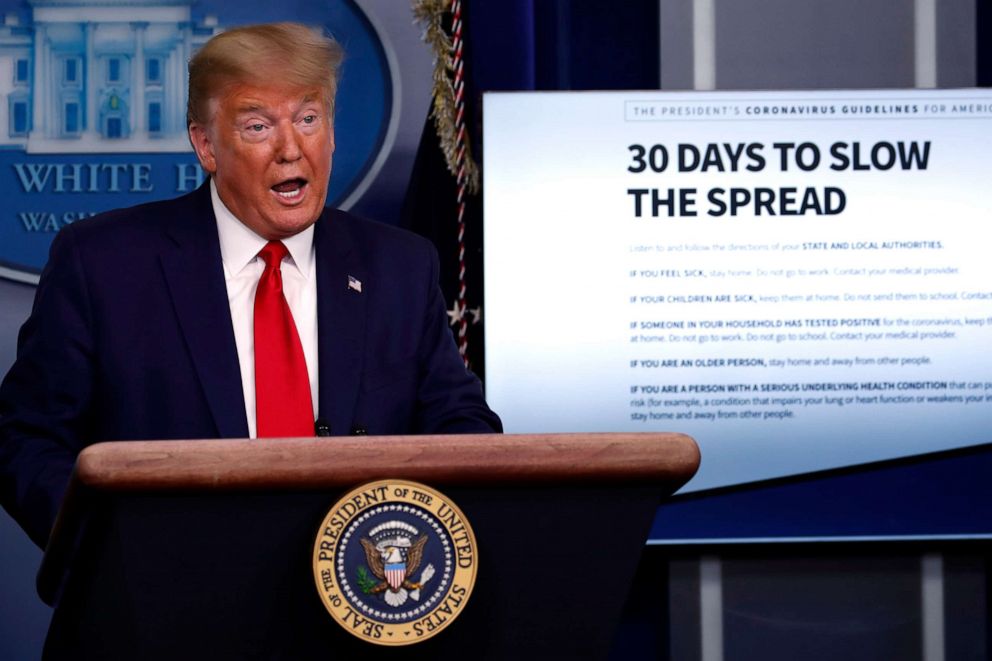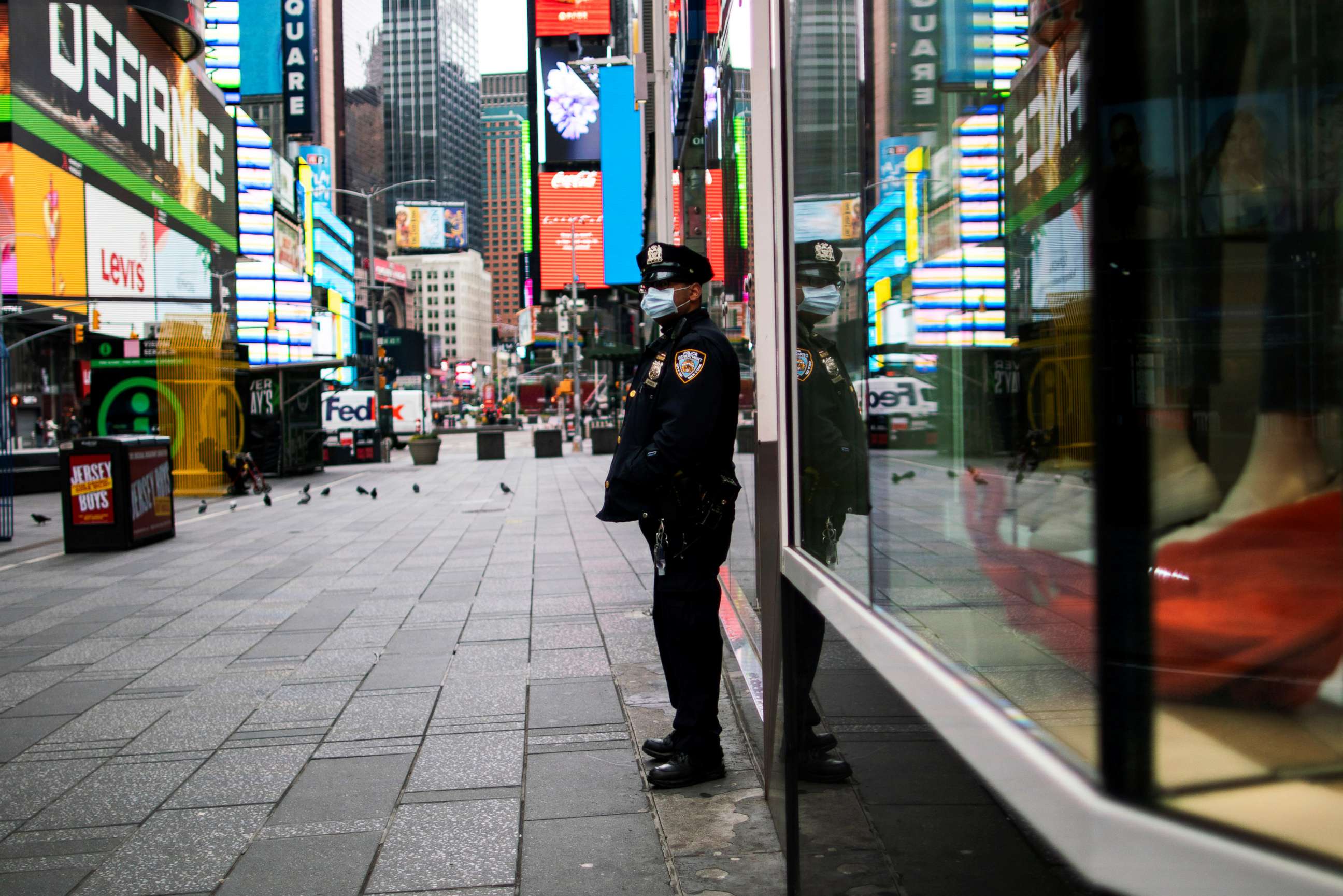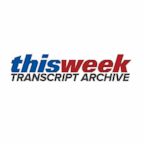A timeline of Cuomo's and Trump's responses to coronavirus outbreak
ABC News looks at how their responses evolved through March.
A day after New York reported its first case of novel coronavirus, Gov. Andrew Cuomo delivered words of confidence to residents.
"This isn't our first rodeo," Cuomo said at a March 2 press conference. "We are fully coordinated, and we are fully mobilized, and we are fully prepared to deal with the situation as it develops."
The governor, however, struck a much different tone, perhaps his most sobering yet, during a press conference on Tuesday.
"We underestimated this virus. It's more powerful. It's more dangerous than we expected," Cuomo said, warning there is no end in sight.
There are at least 93,000 diagnosed coronavirus cases in New York, with more than 2,000 deaths reported, according to data compiled by Johns Hopkins University.
The same day Cuomo, who has been praised by some for his response, made his remarks, President Donald Trump and his administration addressed the nation and called New York's response "a very late start."
Here's a comparison of how New York and the Trump administration responded to the pandemic during the month of March.

March 1
Cuomo announced New York's first confirmed coronavirus patient: a woman in her late 30s believed to have contracted the virus in Iran.
"There is no cause for surprise -- this was expected. As I said from the beginning, it was a matter of when, not if there would be a positive case of novel coronavirus in New York," Cuomo said.
He assured New Yorkers that the general risk in the state "remains low."
The message was along the lines of what other state leaders were telling residents and what the U.S. surgeon general was telling the public.
"#COVID19 is a serious disease, but for the general public the immediate health risk is considered low," Surgeon General Jerome Adams tweeted.
March 2
Cuomo announced that the Wadsworth Center, a public health laboratory within the State Department of Health in Albany, was partnering with hospitals to expand testing capacity to 1,000 tests per day.
The governor also said a new cleaning protocol was being introduced in schools and for public transportation to help contain any spread.
The same day, Trump criticized Democrats, saying "they are fearmongering" and had criticized him when he "closed the country down to China many weeks ahead of what almost everyone recommended."
Trump's travel restrictions to and from China went into effect on Feb. 2. They were not a ban.
March 3
Cuomo reported the state's second confirmed case, along with measures to better equip New York to handle potential spread.
He signed a $40 million emergency management authorization to bring in additional staffing and equipment. Cuomo also amended his Paid Sick Leave budget to safeguard employees who had to stay home from work to isolate or quarantine.
Trump at the time said that the U.S. was monitoring other countries that had been badly affected to see if more stringent measures were necessary to prevent a major outbreak in the U.S.
Vice President Mike Pence, who's chairing the White House Coronavirus Task Force, later said that about 2,500 Centers for Disease Control and Prevention (CDC)-approved testing kits would be sent out by the end of the week.
March 4
Confirmed cases began to slowly rise in New York, with Cuomo reporting a total of 11, up from two from the day before.
A major point of concern at the time were cases in Westchester County, which stemmed from a 50-year-old attorney who tested positive. Three members of the man's family tested positive -- his wife, son and daughter -- as well as a neighbor who drove him to the hospital, according to Cuomo, who warned that the number of cases in that county would reach "dozens and dozens and dozens."
About 1,000 were asked to self-quarantine in Westchester. More measures were enacted, including temporary closures of some schools and a synagogue.
Trump similarly announced more measures, saying there would be health screening checks for passengers entering the U.S. from certain countries where coronavirus is prevalent. He had previously said that there were screening checks prior to departure for people from on direct flights from South Korea and Italy.
The president also incorrectly blamed a delay in testing on the Obama administration.
March 5
Confirmed cases in New York rose to 22, according to Cuomo, with most in Westchester County.
Cuomo urged New Yorkers to remain vigilant.
"Luckily in this country, and certainly in this state, we have the most sophisticated health care system probably on the globe. So, we're coordinated, we're on top of it, we're diligent. But we also have to keep it all in focus," he said.
Trump meanwhile spoke out against criticism of comments he made to Sean Hannity in which the president said some people with mild cases of coronavirus could go back to work.
"I NEVER said people that are feeling sick should go to work. This is just more Fake News and disinformation put out by the Democrats, in particular MSDNC," Trump tweeted. "Comcast covers the CoronaVirus situation horribly, only looking to do harm to the incredible & successful effort being made!"
Trump's comment to Hannity was: "So if we have thousands or hundreds of thousands of people that get better, just by, you know, sitting around and even going to work, some of them go to work, but they get better." Trump noted that he was speaking based on a hunch.
March 6
New York cases jumped from the morning to the afternoon, with Cuomo reporting 33 and then 44, most still in Westchester County.
"I'm not urging calm. I'm urging reality," he said. "I'm urging a factual response as opposed to an emotional response."
Trump visited the CDC in Atlanta and caused confusion when he said, "Anyone who wants a test can get a test."
Pence later clarified Trump's comment: "The president's exactly right that for the state laboratories, for the communities that have been impacted, that have concerns about the coronavirus, we have been able to respond to requests for tests," Pence said.
March 7
A state of emergency was declared in New York after total confirmed cases rose to 76 and reached 89 later in the day.
Cuomo said the declaration allowed for the government to help local health departments that "are very stressed."
March 8
The total number of confirmed cases in New York reached 105, and Cuomo urged those who could, to work from home.
Cuomo also criticized the federal government's response, saying, "We mobilized quickly, but the federal government has been slow off the mark and they continue to be slow. That's unacceptable -- we need them to approve these private labs today so we can stay ahead of this evolving situation."
Trump pushed back on the criticism.
"We have a perfectly coordinated and fine-tuned plan at the White House for our attack on CoronaVirus," he tweeted. "We moved VERY early to close borders to certain areas, which was a Godsend. V.P. is doing a great job. The Fake News Media is doing everything possible to make us look bad. Sad!"
March 9
New York reported 142 confirmed cases, according to Cuomo.
He continued to urge the federal government to approve testing in the state. At the time, Northwell Health, the state's largest health care provider, was completing 75 to 80 samples of manual testing per day, but automated testing on thousands of samples per day still lacked federal approval.
Trump tweeted fatality rates about the flu, seemingly comparing the two diseases. Health experts have noted that coronavirus is not like the flu.
"So last year 37,000 Americans died from the common Flu. It averages between 27,000 and 70,000 per year. Nothing is shut down, life & economy go on," Trump wrote. "At this moment, there are 546 confirmed cases of CoronaVirus with 22 deaths. Think about that!"
That same day, the Trump administration announced it was giving $699,000 to a company that's developing a testing system that could administer 1,000 tests per day, each producing a result in about three hours.
March 10
New York reported 173 confirmed cases, according to Cuomo.
With the majority still in Westchester County in New Rochelle, Cuomo closed down the schools, houses of worship and large gatherings within a mile radius of the city from March 12 to March 25.
"As the number of positive cases rises, I am urging all New Yorkers to remember the bottom line: We talk about all this stuff to keep the public informed -- not to incite fear -- and if you are not a member of the vulnerable population then there is no reason for excess anxiety," Cuomo said.
Trump, however, struck a more optimistic tone: "It hit the world, and we're prepared and we're doing a great job with it, and it will go away, stay calm, it will go away."

March 11
Confirmed cases in New York rose to 216, according to Cuomo, who also said the state had contracted 28 private labs to conduct testing.
"We're continuing to prioritize ramping up testing capacity because the more people you identify as having the virus, the better you can contain it," Cuomo said.
Trump meanwhile acknowledged in a memo an anticipated shortage of respirators.
"Unfortunately, at present, public health experts anticipate shortages in the supply of personal respiratory devices (respirators) available for use by health care workers in mitigating further transmission of COVID-19," Trump wrote to his secretaries of health and human services and of labor.
Trump's campaign also was continuing to hold rallies, despite Dr. Anthony Fauci's earlier recommendation people stay away from large crowds.
March 12
Restrictions in New York increased, with Cuomo announcing that there could be no gatherings of more than 500 people and that any gatherings of fewer than 500 had to reduce capacity by 50%.
Confirmed cases hit 325.
Trump announced in an address from the Oval Office that he would be "suspending all travel from Europe to the United States for the next 30 days."
The Department of Homeland Security later clarified that wouldn't apply to U.S. residents and green card holders in Europe. It would only apply to foreign nationals coming from Europe to the U.S., and travel from the U.K. would still be allowed.
March 13
Cuomo spoke highly about drive-through testing in New Rochelle, noting that he was prioritizing the city because of the high number of cases there. He also said he anticipated, over the next week, to increase testing to about 6,000 per day from 3,000.
Confirmed cases reached 421 in New York.
The same day, Trump declared a national emergency.
"Two very big words," he said during a press conference from the Rose Garden.
The president said doing so would open up $50 billion in additional funding to aid states in their efforts to combat the virus. He also said people should only get tested if they have certain symptoms, but he didn't specify which ones.
"It's totally unnecessary. This will pass," Trump said.
March 14
The first two deaths were reported in New York, as confirmed cases climbed to 613.
"Our goal is to slow the spread of the virus to a rate that the health care system can manage, and we're doing that through aggressive testing and strong social distancing protocols," Cuomo said.
The governor acknowledged that the anticipated wave of new cases "threatens to crash our health care system, and we need national action from the federal government to address the quickly evolving situation now," such as localizing testing, federalizing shutdowns and tasking the Army Corps of Engineers to expand hospital capacity.
Trump later adopted more travel restrictions, extending them to the United Kingdom and Ireland. He also urged Americans not to travel domestically if they didn't have to.
March 15
Schools are ordered to close in New York City, Westchester County and Suffolk County, as statewide confirmed cases reached 729.
Related Stories
Trump offered a more optimistic viewpoint in a press briefing, saying, "There's a very contagious virus, but it's something we have tremendous control over."
However, Fauci later said in the same briefing, "The worst is ahead for us. How we respond to that challenge, that determines what the ultimate endpoint will be."
March 16
Cuomo banded together with New Jersey Gov. Phil Murphy and Connecticut Gov. Ned Lamont to announce that the states were limiting crowd capacity for recreational and social gatherings to 50 people. Restaurants and bars were also ordered to close for dining in, but they still could offer takeout or delivery. Movie theaters, gyms and casinos had to close.
"This is not a war that can be won alone, which is why New York is partnering with our neighboring states to implement a uniform standard ... I have called on the federal government to implement nationwide protocols, but in their absence we are taking this on ourselves," Cuomo said.
Trump later took to Twitter to say that his teleconference with U.S. governors "went very well," before singling out Cuomo, saying he had to "do more."
It was the day same the White House started to implement substantial changes to daily operations, such as having staffers observe social distancing and begin using teleconferencing.
March 17
Cuomo delivered a powerful speech on coming together as Americans.
"This is an extraordinary time in this nation's history. It will go down in the history books as one of those moments of true crisis and confusion and chaos," Cuomo said. "Everybody is afraid. Everybody is nervous. ... What does government do in this moment? It steps up, it performs, it does what it's supposed to do. It does it better than it's ever done it before."
Confirmed cases in New York rose 432 to 1,374.
Trump struck a more aggressive tone in the fight against the spread, saying in a tweet, "The world is at war with a hidden enemy. WE WILL WIN!"
He referred to the crisis as a "war" earlier in the day, but also said, "It will be fine."
March 18
Cuomo ordered all nonessential businesses to decrease in-office workforces by 50% as confirmed cases climbed to 2,382.
He also reiterated that New York would not follow other states by implementing "shelter in place" measures.
Trump tweeted: "I want all Americans to understand: we are at war with an invisible enemy, but that enemy is no match for the spirit and resolve of the American people."
Treasury Secretary Steven Mnuchin announced that the White House was looking into sending checks directly to Americans.
March 19
Cuomo ordered all businesses that rely on in-office personnel to decrease in-office employees by 75% as the confirmed cases hit 4,152.
During an ongoing meeting at FEMA headquarters, Trump spoke again about drugs called chloroquine and remdesivir.
The president boasted about a treatment he said was approved, but the Food and Drug Administration later said it was not.
Trump said use of chloroquine had "had been approved" and "we are going to be able to make that drug available almost immediately."
FDA Commissioner Stephen Hahn later said chloroquine was not yet approved for treatment.
March 20
Cuomo announced all non-essential businesses across the state would have to close under his "New York State on PAUSE" order.
Confirmed cases reached 7,102.
At a press briefing, Trump pushed back after reporters asked again about testing.
"For the hundredth time, I, this administration, inherited an obsolete, old, broken system," Trump said.
Trump also announced he'd invoked the Defense Production Act, which led to confusion over contradictory statements he'd made about whether or not he was actually using it.

March 21
Cuomo said the state would be taking new actions to increase the supply of personal protective equipment.
Confirmed cases hit 10,356.
He also urged New Yorkers to practice humanity during this difficult time.
"Yes, we can be tough. Yes, this is a dense environment. It can be a difficult environment. It can also be the most supportive, courageous community that you have ever seen," Cuomo said. "That is why I am proud to be a New Yorker and to be governor of this great state."
Trump created more uncertainty around whether he was using his authority under the Defense Protection Act. Though he said he'd "invoked" it, he didn't offer any evidence he was using it to force private companies to produce items required by the government.
Hanes, Trump said, was retrofitting factories to make masks.
March 22
Cuomo announced temporary hospitals would be constructed as confirmed cases rose to 15,168.
"We will overcome this, and America will be the greater for it," Cuomo said. "And my hope is that New York is going to lead the way forward, and together we will."
Trump provided numbers on how much medical equipment was being sent to New York, including four large medical stations with 1,000 beds. It was not clear whether this met the state's demand.
March 23
Cuomo said the federal government had deployed hundreds of thousands of masks, gloves, gowns and face shields to New York.
Confirmed cases reached 20,875, but Cuomo urged residents to continue to look at the facts.
"Many people will get the virus, but few will be truly endangered," he said.
Trump said at a press briefing that while the situation is "going to be bad ... we're trying to make it so that it's much, much less bad. And that's what we're doing. And I think we are doing a very good job of it."
He also once again detailed what FEMA was providing to states, saying 73 pallets of PPE had been shipped to New York City. It was not clear whether this met the city's demand.
March 24
Cuomo said again hundreds of thousands more masks, gloves, gowns and face shields were being deployed.
Confirmed cases rose to 25,665.
Trump said at a Fox News town hall he hoped to see the country up and running by Easter, or April 12.
Fauci later said such a date is "very flexible" and "on a literal day-to-day basis."
March 25
Cuomo called New York "the canary in the coal mine" as cases rose to 30,811.
"We have the most positive cases in the nation and the most critical need for equipment and personnel," Cuomo said.
Trump, however, later said that Cuomo was "happy" with the 4,000 ventilators the federal government had sent.
"It's hard not to be happy with the job we are doing, that I can tell you," Trump said.
Cuomo has repeatedly said the state needs more, estimating that in two weeks New York will need 30,000.
March 26
Confirmed cases in New York rose to 37,258.
Cuomo said he hoped to have a facility to take more than 1,000 patients as an overflow site in each New York City borough and in downstate counties.
Trump once more detailed how much equipment states were getting, but those numbers hadn't increased in two days.
March 27
Cuomo applauded the National Guard for stepping up for New Yorkers to help fight the spread -- they brought medical supplies and were establishing medical stations.
The confirmed cases hit 44,635.
Trump said he hoped that governors would be "appreciative" of the "great job" the federal government is doing.
There was an increase in the number of ventilators being shipped out, but the numbers for masks and gowns stayed the same.
March 28
Cases in New York increased to 52,318.
Trump said that he was considering an enforceable quarantine in the New York, New Jersey and Connecticut areas. He later said such a quarantine would not be necessary
Cuomo said he had not spoken to the president about such a quarantine and didn't know what it would entail.
"I don't even know what that means. I don't know how that could be legally enforceable," Cuomo said.
March 29
Cuomo ordered all nonessential workers to stay home for an additional two weeks through April 15.
Confirmed cases reached 59,513.
Trump similarly extended restrictions, saying that he would expand White House guidelines for the country to go until April 30.
Those guidelines include social distancing, working from home, avoiding travel and restaurants, and washing your hands.
March 30
Cuomo welcomed the USNS Comfort to New York City to provide more hospital beds.
Confirmed cases in the state reached 66,497.
Trump said he had not discussed the idea of everyone wearing a mask in public, but later added, "I could see something like that happening for a period of time. But I would hope it would be a very limited period of time."
March 31
Confirmed cases in New York reached 75,795, according to Cuomo.
Trump later appeared to blame the number of cases in New York on the state, for its "very late start."
He also said that while a lot of people have said the U.S. should think of it like the flu, "It's not the flu."
Trump has previously compared novel coronavirus to the flu.
Cuomo's communications director later issued a statement: "This is not the time to debate, but the states were not slow to respond -- the federal government was absent."
ABC News' Will Steakin, Ben Gittleson, Katherine Faulders, Soorin Kim, Olivia Rubin, Jordyn Phelps and Josh Margolin contributed to this report.
